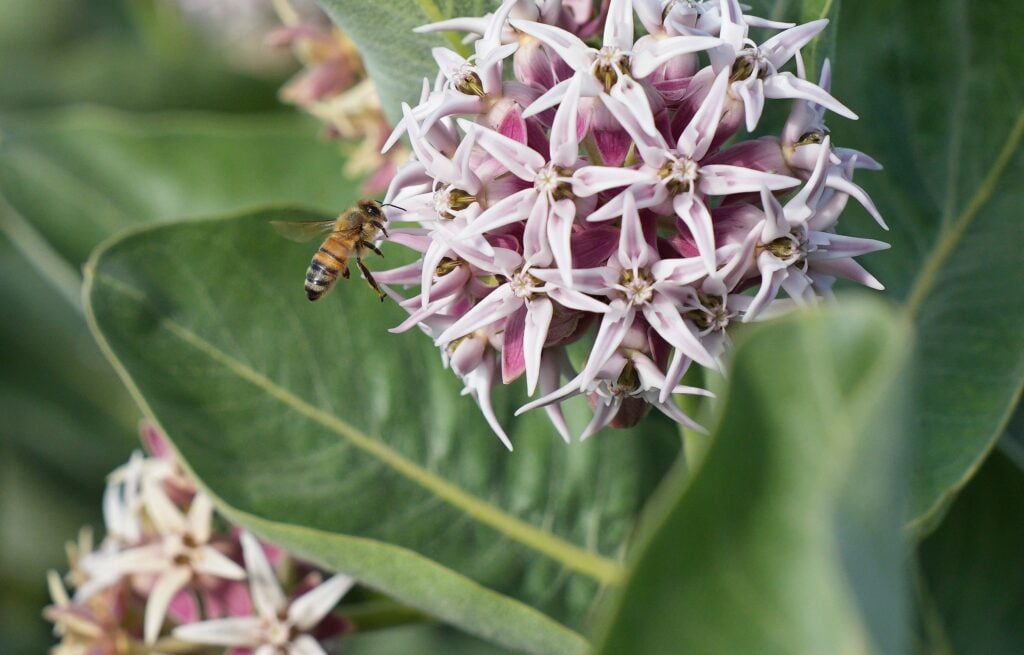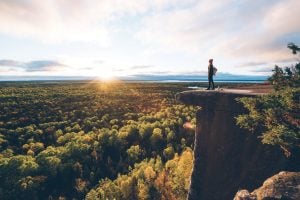1. 16th Avenue roadside naturalization
This primary treatment area was used to test the concept of naturalizing roadsides. The city looked for external partners to work with in-house subject matter experts such as parks ecologist Jenna Cross. ISL Engineering helped design the project along with Dr. Mathis Natvik, a prairie grassland restoration specialist from the University of Calgary. After a competitive bidding process, Earthmaster Environmental Strategies was selected to execute the design. Dr. Mindi Summers, a University of Calgary zoologist and bee researcher, assessed bee populations.
First year outcomes from the initial planting included a brilliant display of orange and red Gaillardia (also called blanketflower, a sunflower relative native to the prairies). In subsequent years, native grasses germinated and replaced some of the flower cover while expanding habitat for pollinators. Askey is optimistic the pilot project results will support the naturalization of other areas around Calgary.
2. Sarcee Trail
Although the city now has a formal biodiversity strategy, employees have been innovating for many years.
Approximately two decades ago, a city employee responsible for mowing the vast roadsides of Sarcee Trail questioned why so much effort went into planting turf grass only to spend a lot of time mowing it. It was agreed that the area would only be mowed once a year instead of four and the savings redirected into planting native species. Some native plants were planted and others spread organically as mowing frequency decreased. Now the area provides a tall grassland backdrop for cyclists and pedestrians weaving through the green space on the multi-use pathway adjacent to Sarcee Trail.
These less manicured spaces have proven to be vital for increasing pollinator density. A city-wide survey by University of Calgary researchers found boulevards with turf grass mowed several times a year had zero bees per hectare. In un-mowed roadside areas, there were 3,000 bees per hectare.
3. Nose Hill Park
Calgary sits at the northern tip of the Great Plains ecoregion, which stretches all the way to Mexico and prior to European settlement was dominated by grassland habitat. Researchers and gardeners seeking to learn what plants will do well in Calgary’s hot summers, cold winters and short growing season can look to Nose Hill Park in the city’s northwest for inspiration, as the park is one of the most significant grassland ecosystems remaining in Canada and the largest of the City of Calgary’s parks (Fish Creek park is larger but it’s a provincial park). Two ecoregions – aspen parkland and fescue grass – offer visitors the chance to admire many plant species including prairie crocus, three flowered avens and golden bean, and at 11 square kilometres, it’s large enough to support coyote, porcupine and deer populations.
4. Mayland Heights Mini Forest
Japanese botanist Akira Miyawaki invented tiny forests to accelerate forest growth and offer city dwellers a way to add significant biodiversity in small places. In 2022, the City of Calgary planted a mini forest on 1,000 square metres of underused park space next to a playground in the Mayland Heights neighbourhood. More than 4,000 trees, shrubs and forbs from 26 native plant species were squeezed into the planting area, with one canopy tree, one sub-canopy tree, one shrub and one forb in each square metre.
“In Calgary’s climate it’s quite challenging to get species established,” says Jason Weiler, Parks Ecologist, Parks & Open Spaces. “This planting is much more dense than traditional forestation methods. It mimics the natural forest succession process. Where there’s an open space, the plants compete for light and resources. That is supposed to promote much faster establishment.”
5. Crescent Heights Pollinator Planters
Several years ago, a group of residents of the inner-city Crescent Heights neighbourhood expressed concern about the city’s plans to remove street planters from Crescent Road NW and asked if they could take over the care of the planters. The city agreed, and in 2020, Park Ecologist Jenna Cross got involved, offering suggestions on what to plant. Finding native plant species is an ongoing challenge for the city. It’s hard to scale up naturalization projects because there are so few places to source native seeds. Eastern Slopes Rangeland Seeds north of Calgary experiments with new native plant species and sells cultivated seeds, but large contracts need several months lead time.
In the meantime, Cross helps this micro naturalization project by transplanting native species from her own garden. “I’ve designed these planters to ensure that we have different species blooming all growing season for the bees. Supply is always an issue,” she says.
6. Canyon Meadows Bee Boulevard
Calgary is home to more than 100 native bee species and 14 bumble bee species. Making space for bees while the city grows is important in maintaining biodiversity. When the median on Canyon Meadows Drive needed upgrading, planners suggested a half-hectare naturalization project, planting 22 species of salt-tolerant grasses and pollinator-friendly wildflowers in 2017.
Nearby, overlooking Fish Creek Provincial Park, is a habitat devoted to bees. Area students helped plant 600 hundred showy milkweed. To help the bees multiply, a variety of nesting habitats were added, including “bee hotels” made from recycled logs, bumble bee houses, cavity-nesting options, and a sand bed.
In 2018, University of Calgary researchers discovered two endangered gypsy cuckoo bumble bees on the site, and in 2019, Calgary became Canada’s 36th Bee City, a certification awarded by Bee City Canada to cities that support pollinators and their habitats and make efforts to connect people to nature and locally grown food.
7. Bridgeland Rain Garden
In this engineered rain garden, stormwater is directed into a depression where plants, soil and gravel filter the water before it makes its way into city rivers. Cleaner water helps fish, while hardy, low-maintenance plants can also attract birds and insects like dragonflies that eat mosquitoes. The City of Calgary encourages residents to create rain gardens in their own yards to collect excess rain and melted snow.
8. Inglewood Bioengineering Demonstration Project
Walloped by the historic 2013 flood, the riverbanks between Pearce Estate Park and the Inglewood Bird Sanctuary became unstable. Engineers turned to bioengineering — a combination of living and non-living plant materials along with other support structures — to stabilize slopes, reduce erosion, and establish new vegetation.
Along this stretch of river, where terrestrial and aquatic environments meet, native plants such as balsam poplar and willow species were seen as important allies in reducing bank erosion. Grasses and willows found in the splash zone protect the bank from scouring, soak up or slow floodwater and shelter aquatic and terrestrial creatures. Balsam poplar stabilize river banks, slowing and absorbing floodwater and creating forest habitat for wildlife.
Interpretative signage along the river explains the added benefits of the bioengineering project, including enhanced fish habitat and a corridor for urban wildlife.
9. Inglewood Bird Sanctuary and Chinese Market Gardens
The much-loved Inglewood Bird Sanctuary sits on the west side of the Bow River, one of three bird sanctuaries in Alberta and one of the only Canadian bird sanctuaries found in an urban area. Work is underway to restore bank swallow habitat damaged by the 2013 flooding and add pools and riffles for fish habitat. A channel will connect the main lagoon to the Bow River for better water quality and to provide safe passage for fish.
In 1929, around the same time Colonel James Walker — one of Calgary’s most influential early citizens and founder of the Calgary Agricultural Society (the forerunner of the Calgary Stampede) — asked the federal government to establish the sanctuary, he leased land to several Chinese families for market gardens, which grew produce for the expanding city. The City of Calgary is now designing the Chinese Market Gardens project to explain how the land was used before it became a sanctuary. The project will also investigate assisted migration of plant species with an eye to seeing if planting species from climate zones south of Calgary will help the area be more resilient to climate change.
10. The Water Centre
This striking structure is Alberta’s first LEED Gold certified building and headquarters for the city’s water experts. The grounds have zero-irrigation, drought-resistant landscaping and the maintenance facility has a green roof. Situated in an industrial area, the facility with its native vegetation provides a stopping place for pollinators transiting the area.
11. Dover Neighborhood Street Improvement Project
This community in southeast Calgary was heavy on roads and light on park space so an underutilized roadway was converted to bike lanes and the boulevard turned into a naturalized area. Planted in the fall of 2022, some of the young plants didn’t survive an intense heat wave this past spring. Says Askey, “This might be an example where the first time around, it hasn’t been as wildly successful, but we learn as much from failure as we do from success.”
Earthmaster’s Kent Cryer isn’t giving up: “We’ll mow [in some places]. We’ll plant again,” he says.
Community residents may be disappointed the summer didn’t bring pretty blooms, but Askey sees it as an opportunity for public education. “People ask, ‘Why doesn’t this look like those planters over there?’ This is not a beautification process. It’s not going to look terrible, but these things are about a balance of form and function. It will look different from manicured turf grass. It will look different from planters and ornamental treatments. What we are trying to get to is that urban meadow look.”
12. Memorial Drive Roadside Naturalization
Blue flax flowers wave in the wind as drivers and pedestrians pass by the tall grasses of this naturalization project. Although it was accidentally mowed in its early phases, it has grown into a successful example of how native plants can create a more diverse and productive roadside landscape.
“A lot of people will be indifferent to this and that’s fine,” says the University of Calgary’s Natvik. “I really like the idea of doing interchanges like this. You get wider spaces; you get quieter places back from the traffic.”
People may not give much thought to their boulevards and roadsides, but because the City of Calgary is, community residents are benefiting from increased biodiversity — and that’s good for all of us.
Inspired by what the City of Calgary is doing to protect and restore its native biodiversity? Learn more about how you can help Canadian Geographic build a national Network of Nature.
Join the Network of Nature


















